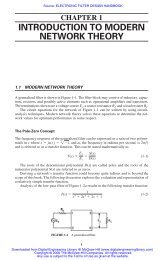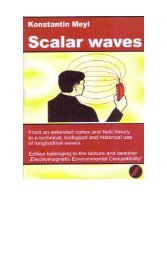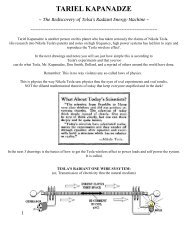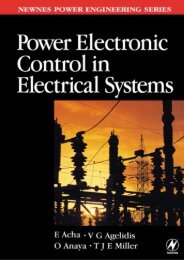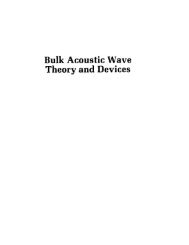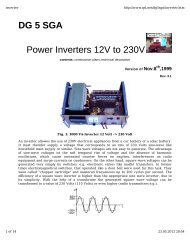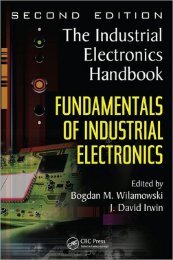New Energy Technologies Magazine nr 3 2005.pdf - Index of
New Energy Technologies Magazine nr 3 2005.pdf - Index of
New Energy Technologies Magazine nr 3 2005.pdf - Index of
You also want an ePaper? Increase the reach of your titles
YUMPU automatically turns print PDFs into web optimized ePapers that Google loves.
A new view on thermotransformation process allowed me to invent<br />
a new kind <strong>of</strong> a thermotransformer with better energy efficiency.<br />
I am searching for an investor (for patenting and realization).<br />
Actuating body inlet (P 0<br />
, T 0<br />
)<br />
Hot stream (P 1<br />
, T 1<br />
)<br />
Cold stream (P 2<br />
, T 2<br />
)<br />
To the resonance pipe’s<br />
nozzle (Fig. 3, pos. 2)<br />
Figure 1. Ranque’s vortex thermotransformer (the classical design)<br />
1 – spiral gas supply; 2 – energy division chamber; 3 – diaphragm; 4 – throttle-unswirler;<br />
5 – resonator (a noise blanking device); 6 – reflector (adjustable);<br />
7 – fitting for cooled gas outlet; 8 – counter-nut; 9 – external beading.<br />
division chamber had a form <strong>of</strong> a tube. Its forms<br />
have been improved over seventy years; this<br />
can be seen in Fig. 1 (an internal cylinder-conic<br />
cavity, a resonator for noise blanking, an<br />
external fanning). It is still unknown how<br />
thermotransformation occurs, though there are<br />
a lot <strong>of</strong> theories claiming to explain this process<br />
[5]. It is impossible, for example, to base the<br />
thermotransformation explanation on the<br />
molecular-kinetic theory (including centrifugal<br />
and pressure forces in a model) because molecules<br />
moving along a free path run, as it is well known,<br />
uniformly and in straight lines. Attempts to use<br />
average environmental parameters in the<br />
thermotransformer’s chamber will lead into a<br />
dead end. In 1895, Osborn Reynolds suggested<br />
to describe a kinematics <strong>of</strong> the vortical motion<br />
on basis <strong>of</strong> statistical (probabilistic)<br />
characteristics. But even now manuals (for<br />
example, [6]) impose such a disputable approach.<br />
If we translate a “probabilistic nature” into<br />
ordinary language, it means that vorticity is an<br />
effect, which occurs sporadically, i.e. it is a rather<br />
vague, unstable substance. Then, this ephemeral<br />
instability can easily, for instance, cut a tail unit<br />
<strong>of</strong> 300 aerobus (as it happened above a <strong>New</strong><br />
York suburb on the 12th <strong>of</strong> November 2001.<br />
And a vortex trail <strong>of</strong> a Japanese air liner, which<br />
took <strong>of</strong>f a couple minutes earlier, was just the<br />
“instability”). However, a life time <strong>of</strong> an air<br />
structure (the vortex trail) is much less than<br />
that <strong>of</strong> the above mentioned vortex lenses.<br />
I think it is obvious now that it is rather difficult<br />
but also very important to describe the energy<br />
division process. It must be taken into account<br />
that Ranque’s vortex device is the first example<br />
<strong>of</strong> the anti-entropic systems designed. If an<br />
initial gas in the chamber is expanded, entropy<br />
(a disorder degree) decreases! A Nobel Prize<br />
laureate Ilya Prigozhin has created<br />
thermodynamics <strong>of</strong> irreversible processes. But<br />
even it cannot completely explain the discrepancy<br />
between real processes in the vortex<br />
thermotransformer and theoretical consequences<br />
<strong>of</strong> the second law <strong>of</strong> thermodynamics. It remains<br />
only to be happy because scientific orthodoxes<br />
have now less opportunities to hamper anything,<br />
which does not fall into their a priori patterns. I<br />
will give a historical fact, which directly<br />
concerns the article’s topic.<br />
In the beginning <strong>of</strong> the 1960th, the Soviet press<br />
attracted attention to a phenomenon <strong>of</strong><br />
“Babiegorodsky pereulok”. In a basement <strong>of</strong> one<br />
<strong>of</strong> the houses <strong>of</strong> this Moscow side street, a<br />
group <strong>of</strong> physics (“odd fellows”) found out that<br />
26 <strong>New</strong> <strong>Energy</strong> <strong>Technologies</strong> #3(22) 2005






